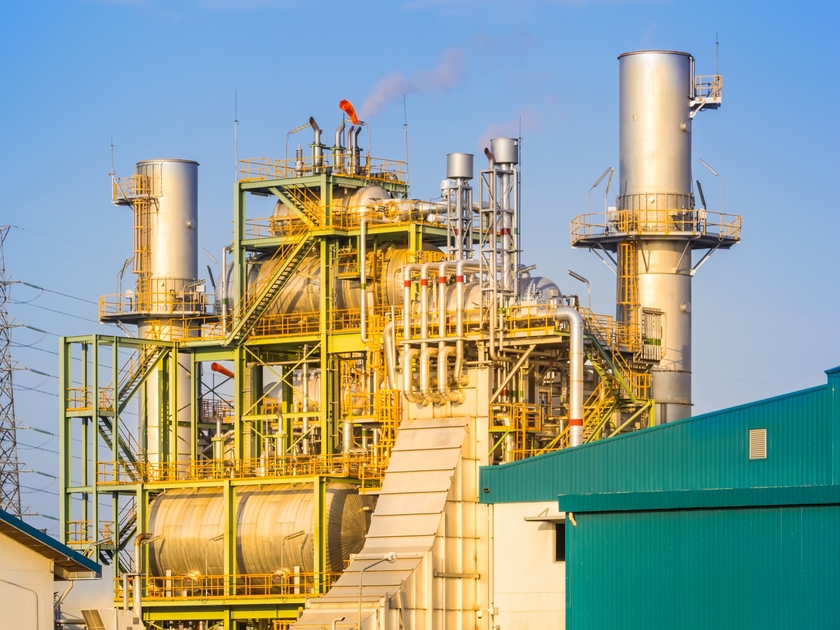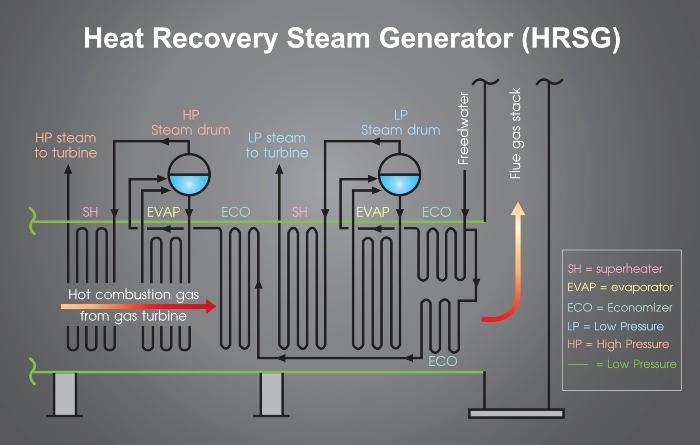Industrial process heating and combined heat and power (CHP) turbine generators produce a massive amount of waste heat. Turbine exhaust temperatures can reach 1,100°F. One way to recover that heat is with a heat recovery steam generator (HRSG) plant. The waste heat is supplied to the HRSG where it's converted into steam for use in a process application or to drive a steam turbine generator.
How heat recovery steam generators work
HRSG plants consist of four major components: the superheater, evaporator, economizer and water reheaters. Multiple pressure HRSG units have separate drums to separate steam from water for low-pressure (LP), intermediate pressure (IP) or high-pressure (HP) steam. The higher the steam pressure, the higher the exit gas temperature from the evaporator and the lower the steam generation rate. That's why the IP and LP sections are desirable.
Because the difference between the gas temperature leaving the evaporator and the temperature of saturated steam is relatively small (15°F to 30°F) for an HRSG compared to a steam boiler (150°F to 400°F), the heating surface area must be maximized. Heat exchanger tubes are covered in fins to enlarge the surface area. Parallel rows of finned tubes, called racks, are welded to manifolds. Multiple racks make up a module. Each module has a steam drum and an evaporator section where water is converted to steam.
The evaporator consists of many pipe loops from the headers connected to the steam drum in parallel. This wet steam then passes through superheaters to raise the temperature beyond the saturation point. Liquid water in the bottom of the drum is returned to the evaporator tubes through piping. Makeup feedwater passes through the economizer tubes, preheating the feedwater, before it's released into the drums.
Types of heat recovery steam generators
Horizontal drum HRSG units are the most popular type of steam generator. The gas flow is horizontal while water flows through vertically arranged evaporator tubes. No pumps are used. Natural circulation moves water through the system. When site space is limited, a HRSG can be arranged with vertical gas flows across horizontal evaporator tubes using forced circulation pumps.
A less commonly used type of HRSG is the once-through steam generator (OTSG) without boiler drums. In this design, the inlet feedwater follows a continuous path without the need for segmented sections for economizers, evaporators or superheaters. The reduced mass makes OTSG much more tolerant to the rapid thermal cycling experienced with natural gas turbines.
A number of HRSG options are available, such as supplemental firing, selective catalytic reduction (SCR) for nitrogen oxide (NOx) abatement, a catalyst for carbon monoxide (CO) emissions reduction and exhaust gas bypass systems for start-up or downtime. Some HRSG plants include supplemental firing for steam production at reduced gas turbine load. These supplemental burners provide additional energy to the unit, which produces more steam and increases the output of the turbine. A wide range of fuels can be used, including natural gas, hydrogen, fuel oil or biogas.
The steam from HRSG plants can be used for petrochemical or desalination plants, or to produce steam or hot water from CHP plants for district heating or cooling. New York University's microgrid consists of two 5.5 MW gas turbines coupled with heat recovery steam generators and a 2.4-MW steam turbine.


